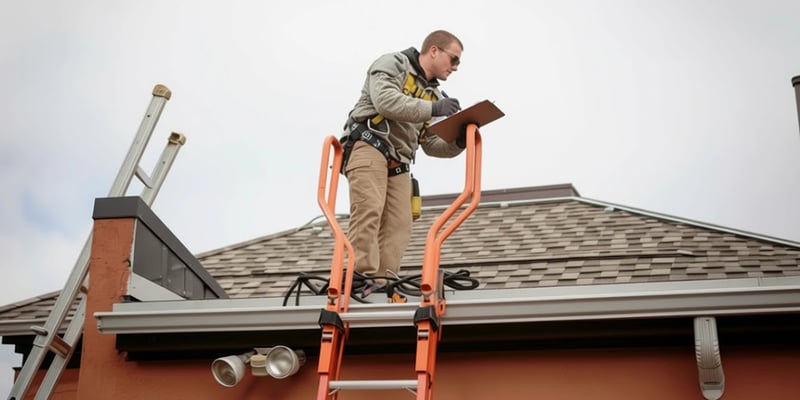- Home »
- Learningcenter »
- Lenders roof condition reports
What Atlanta Lenders Check in Roof Condition Reports

When Atlanta lenders review your mortgage application, they care about three main factors. Your credit score matters, your income matters, and, believe it or not, your roof matters just as much. Georgia has a tough climate for roofs. The humidity speeds up deterioration, and those thunderstorms we get every summer put plenty of stress on shingles. Because of this, roof assessments in our market are much stricter than what you'd find in other parts of the country.
A roof that does its job and keeps the rain out could still cause your loan to get denied. Inspectors come out with a whole checklist of items that they need to review on your property. They'll look at the age of your roof, check for storm damage and make sure that the whole structure is actually sound. You could have a 16-year-old asphalt shingle roof that feels sturdy as a rock as you walk on it. The problem is that the same roof might still create financing problems or kill your loan completely. Lenders run the numbers on how much life your roof has left in it, and they make lending decisions based on those calculations.
Insurance firms have also become much stricter over the past few years. After paying out millions in weather-related claims, they've changed their policies quite a bit. Some insurers won't even write coverage on older roofs anymore. This causes a big problem because lenders need proof of insurance before they'll close on your loan. Another issue is old repair work. Maybe you had some work done five years ago and never got the right permits. That paperwork problem can show up during the documentation review process. When it does, it can stop your entire transaction just days before you're supposed to close.
Inspectors take dozens of photos during their evaluation. They measure specific areas and compile detailed reports for the underwriters to review. Every part of your roof gets scrutinized in ways that most homeowners never think about.
Here's what lenders actually look for when they check your roof's condition!
Your Roof Age and Mortgage Approval
Lenders in Atlanta are going to want to know the exact age of your roof well before they'll even think about your mortgage application. What they're actually after is something that inspectors call the usable life of your roof materials. Most mortgage lenders need to see that your roof has at least 2-3 years of life left in it, and that's the absolute minimum they'll accept.
The age requirement is a big problem for a lot of homeowners. Any roof with standard asphalt shingles that's already passed the 15-year mark is going to make lenders pretty nervous about the whole deal. Your roof could be keeping every drop of rain out just like it's supposed to. But lenders see an older roof as a financial problem that they also need to protect themselves against.
Inspectors actually have a few different methods that they use to find out how old your roof is. The first thing they'll do is check the permit records down at the county office. Sometimes they find manufacturer stamps directly on the roofing materials themselves, and that makes their job easier. When neither of those approaches pans out, though, they have to look at wear patterns and use their experience to come up with an educated estimate of the age.

Different types of roofing material hold up differently in Georgia's weather, and the differences are pretty big. Metal roofs are your best bet if you want something that lasts a long time, since they'll last 30-50 years without any serious problems. Asphalt shingles don't hold up nearly as well and usually need replacing after 20-25 years. Clay and concrete tiles can outlast metal roofs, but only if your contractor did the installation right from day one.
The age of your roof is going to affect your loan application in a few other ways. Lenders actually calculate depreciation into their loan-to-value ratios as roofs get older and get closer to replacement time. Some mortgage lenders will even make you set up a separate escrow account specifically for saving money toward the eventual roof replacement.
Maintenance records from over the years can save the day if you have them available to show your lender. Regular professional inspections and even minor repairs can sometimes be enough to convince lenders that they should look past their usual age requirements. Just remember that documentation from licensed professional roofers is going to carry a lot more weight with lenders than any receipts from repairs that you did yourself.
How Inspectors Find Your Roof Damage
Atlanta weather is tough on roofs, and every lender in the city knows it. Those summer thunderstorms and random hail events do real damage to shingles over the years, and that's why banks look at roof reports so closely during the loan process. They need to know just what Mother Nature has been doing to your property.
Roof inspectors have developed their own methods to find damage that most homeowners would never see from ground level. Those small dents in your shingles from hail strikes are almost invisible from the street, but inspectors know just where to look for them. Wind damage is another big concern because it slowly lifts the edges of shingles bit by bit and creates weak points all across the roof. Granule loss is equally bad since those little protective particles are what stop the sun from destroying your shingles, and once they wash away, you have bare patches that deteriorate fast.

A roof doesn't have to be actively leaking for a lender to demand repairs before closing. Even minor hail marks from the storms that happened months ago can become a mandatory repair condition on your loan approval. Banks view those small dings as problems that are only going to get worse over time, so they want them fixed right away.
Roof inspectors actually have to separate damage into two different categories for lenders. Some damage is purely cosmetic and doesn't affect how well the roof protects your home. Other damage is functional-the roof can't do what it's supposed to anymore. Lenders care about each one of these categories because even cosmetic damage shows them that a roof has been compromised and might fail sooner. Functional damage is obviously worse since your roof is already failing at its primary job of keeping the water out.
Fresh damage is always more concerning than old damage to lenders. Any storm that has rolled through your neighborhood in the past 6 months is going to raise questions, and you'll need documentation that the repairs were completed properly. The damage from the past 12 months gets the most scrutiny because recent storms usually create cascading problems that get progressively worse with each new storm.
When Lender and Insurance Standards Don't Match
Water damage and insurance requirements have become a challenge for Atlanta lenders. The extreme weather that's been hitting Georgia over the past few years has changed everything about how insurance companies review roofs. Most insurers have set a hard line now, and they just won't cover any roof that's more than 20 years old. It doesn't matter if that roof looks brand new or if it just passed a professional inspection with flying colors.
The whole situation turns into a massive headache for everyone who's trying to buy or sell a house. Lenders need to see proof that you can get homeowner's insurance before they'll approve your loan. Meanwhile, insurance companies flat out refuse coverage when they think that a roof is too old or creates too much risk. Buyers and sellers get stuck right in the middle of this mess.
I see sellers who run into this exact problem all the time. A roof passes the lender's inspection with zero problems or red flags whatsoever. The insurance underwriter then pulls up the manufacturing date in their system and denies the coverage right away. At that point, the whole transaction falls apart - even though the roof itself is in perfectly fine condition.

What makes this even more confusing is that lenders and insurers are actually looking for different criteria when they review a roof. Lenders mainly want to know if you have any active leaks or structural problems that could affect the home's value. Insurance companies care way more about the roof's age, the materials that were used, and how well it holds up in bad weather. Since they're looking at different criteria, the same roof can pass one inspection and fail the other.
A few strategic upgrades can work for lenders and insurers at the same time. Impact-resistant shingles have also taken off in the Atlanta market because they meet the requirements that both parties are looking for. These materials are more expensive up front, yet they can save an entire transaction from falling apart. Insurance companies will occasionally issue temporary certificates of insurability that can buy you some time to negotiate repairs or work out a replacement plan with the seller.
Code Requirements That Lenders Check
Lenders always send out their own inspectors to take a close look at your roof, and these inspectors are specifically trained to find any problems that might come up that could cost money down the line. What they're actually after is evidence that your roof will stand up to whatever weather Atlanta throws at it. Any areas where the roof has started to sag or dip down are going to be a problem. Atlanta has pretty mild winters, usually. But we do occasionally get those ice storms that can dump heavy weight on top of your house. A roof that seems fine during a July inspection could buckle under all that ice come January or February.
The inspector is also going to check out how the weight gets distributed across your entire roof structure. What they need to find are the right support beams in all the right places and the strong wood decking underneath your shingles. Any soft areas in the wood or signs of rot in that decking will give the lender doubts about approving your loan.

Atlanta has actually updated its building codes a few times over the past 10 years or so. Because of these changes, plenty of older homes don't meet the standards anymore - even though they were meeting the code when they were originally built. Hurricane straps have become mandatory now, and these connect your roof directly to the walls for extra stability. The ventilation requirements have also become much stricter than they used to be. Houses built 30 or 40 years ago probably don't have these newer safety features. Most homeowners don't know that lenders need these upgrades to meet the codes, even if your roof has been working just fine for the last two decades. The fact that your old setup was grandfathered in for normal everyday use doesn't matter one bit to the bank.
DIY repairs can cause all sorts of problems during the lending process. Maybe you fixed a leak on your own a few years back, or you decided to install a skylight without pulling the right permits first. Banks view any unpermitted changes as big liability problems. The quality of the work might actually be perfectly fine. But without those official permits and inspection records, lenders just won't sign off on it.
Ventilation is important for roof inspections. Your roof needs soffit vents along the bottom edge and ridge vents at the peak, and these have to work together to get the air moving through your attic space. When air can't circulate the way it should, the moisture gets trapped up there, and the wood starts to rot. The damage happens slowly, but it gets expensive fast.
Photos and Papers for Your Loan
Lenders are extremely particular about roof condition reports, and they have valid reasons for it. They need to see thorough photos that show every side of your roof, along with close-up shots of the flashing around chimneys and any areas that could be problematic. A handful of ground-level photos used to be acceptable years ago, but that's not at all the case anymore.
The timing of your inspection report is another big factor that trips up a lot of borrowers. Most lenders will reject any report that's more than 60 to 90 days old. They need up-to-date information about your roof's condition because conditions can change quite a bit in just a few months. Last year's inspection might as well be ancient history as far as they're concerned.
A receipt from your roofer isn't enough documentation for loan approval. Lenders need to see photos of the completed repairs, and they also need an inspector to verify that the work meets the building standards. Banks and mortgage firms have strict documentation requirements that they have to follow for every loan they approve.

A standard home inspection isn't always enough for what lenders need anymore. Most of them want you to get a separate roof certification, and it needs to come from somebody who only does roofs for a living. These roof experts check for various issues that your usual home inspector probably won't even think to look for.
Drone photography has changed the way that lenders document roofs. Nobody has to climb dangerous ladders anymore just to get a few simple photos. Drones fly up and capture sharp images of every inch of the roofing material instead. Lenders love this technology because it gives them all the visual proof that they need to make sound loan decisions.
Protect The Roof Over Your Head
Lenders have particular requirements for a reason, and when you know what they're after, the whole process gets much less stressful. Nobody wants to get hit with requests for expensive repairs just two weeks before the closing. At that point, you're already juggling dozens of other tasks and deadlines.
More homeowners are now having their own inspections done way ahead of time (long before the for-sale sign goes up in the yard), and it gives them plenty of breathing room to fix whatever needs fixing without a buyer breathing down their neck. Buyers also love it when you have all your inspection reports and repair paperwork ready to go from day one because it shows them that you're organized and you've done your homework. Just remember to hang onto all your receipts, photos and inspection reports in a folder somewhere. You never know when you'll need to dig them back up, whether it's months or years later.

Lender requirements may look pretty strict the first time you see them all laid out. These standards are there for a reason, though - nobody wants to get stuck with a $10,000+ repair bill the week after they move in. A professional roof assessment only costs $300-400 anyway - it's a small price to pay when the alternative could be a qualified buyer walking away or having to drop your asking price by $5,000+ at the last minute.
Colony Roofers does commercial and residential roofing work, and we have offices all throughout Georgia, Florida and Texas. Our team has been doing this long enough to know what lenders need in their roof inspection reports. We'll give you an assessment that helps keep your investment safe and your family protected, too. Experience really matters with roof repairs and installations. Give Colony Roofers a call for a free inspection, and our crew will take care of your roofing project the right way!
 Call (678) 365-3138
Call (678) 365-3138


.jpg?width=352&height=352&name=roof%20leaks%20(1).jpg)
